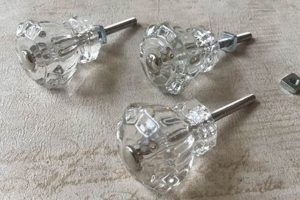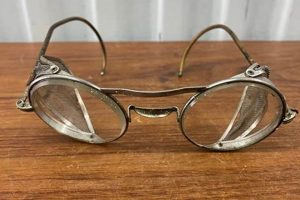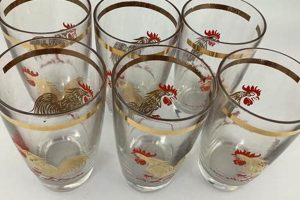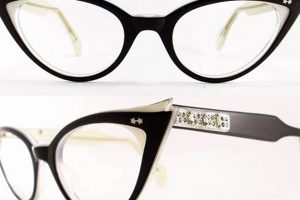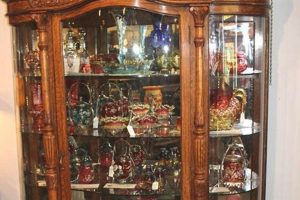These decorative strands are composed of individual glass beads, often strung together on thread or wire. Produced primarily during the early to mid-20th century, these adornments were frequently used to embellish Christmas trees, mantels, and other areas of the home, adding sparkle and visual interest. They represent a popular decorative element of their era.
Their appeal lies in their aesthetic value, historical significance, and relative scarcity. These delicate objects offer a tangible connection to past holiday traditions and design sensibilities. They provide opportunities to create authentic vintage-inspired displays. Original examples in good condition are becoming increasingly desirable to collectors and those seeking unique decorative items, giving them inherent value.
The following sections will explore the materials, manufacturing techniques, identification, preservation, and various applications of these decorative strands, as well as providing guidance on how to incorporate them into contemporary designs.
Guidance on Handling Glass Bead Strands
The following are recommendations for acquiring, assessing, and maintaining decorative strands featuring glass beads produced in past eras. Proper care ensures longevity and preservation of these often fragile items.
Tip 1: Assess Condition Carefully: Before purchasing, meticulously examine the entire strand. Note any chips, cracks, missing beads, or damage to the stringing material. Pre-existing flaws affect value and require careful handling.
Tip 2: Handle with Clean, Dry Hands: Oils and dirt can degrade the surface of the glass and the stringing material. Prior to handling, ensure hands are clean and dry.
Tip 3: Store Properly: When not in use, store the strand flat in acid-free tissue paper within a padded box. This prevents tangling, breakage, and exposure to light, which can fade certain colors.
Tip 4: Avoid Direct Sunlight and Extreme Temperatures: Prolonged exposure to sunlight can cause discoloration or fading. Extreme temperature fluctuations may compromise the integrity of the glass.
Tip 5: Clean Gently and Sparingly: If cleaning is necessary, use a soft, dry brush to remove dust. Avoid using water or harsh cleaning agents, which can damage the beads and string.
Tip 6: Be Mindful of Lead Content: Many antique glass beads contain lead. Exercise caution when handling, particularly around children, and wash hands thoroughly afterwards.
Tip 7: Consider Professional Restoration: For significant damage or disrepair, consider consulting a professional restorer specializing in antique glass. Attempting repairs without expertise may cause further harm.
Adhering to these guidelines extends the lifespan and maintains the aesthetic qualities of these decorative objects. Responsible handling ensures they can be appreciated for generations to come.
The subsequent sections will explore various creative applications for these strands and how to integrate them into modern decorative schemes.
1. Material composition
The constituent materials of these decorative strands are paramount to their value, durability, and appearance. Glass formulation significantly influences the bead’s refractive index, color, and susceptibility to degradation. Examples of early 20th-century strands often feature glass with a high lead content, which imparts a distinctive brilliance and clarity but renders the beads more vulnerable to scratching and chemical reactions. The presence of specific colorants, such as selenium for red hues or cobalt for blue, is also directly linked to the glass composition and provides clues about the origin and manufacturing era. Furthermore, the quality of the stringing material, typically cotton or linen thread, affects the garland’s overall structural integrity and its ability to withstand handling.
Variation in the material composition of the beads and stringing translates directly into diverse levels of preservation challenges and handling requirements. For instance, strands containing beads with a high alkali content are more prone to surface clouding and irreversible damage from atmospheric moisture. Conversely, beads made with more stable glass formulations may exhibit greater resilience over time, requiring less intensive conservation efforts. Careful material analysis, through non-destructive techniques like X-ray fluorescence, can provide invaluable insight into the composition of the components, allowing for tailored conservation strategies and informed appraisal.
In conclusion, the material composition serves as a foundational element in understanding these artifacts, impacting their aesthetic qualities, fragility, and the strategies necessary for their long-term preservation. Recognizing the interplay between glass formulation, colorants, and stringing materials is critical for accurate identification, valuation, and the development of appropriate conservation protocols, ensuring these decorative items endure for future generations.
2. Manufacturing techniques
The techniques employed in the creation of glass beads significantly impact the characteristics and value of these garlands. Examination of the manufacturing processes provides insights into the origin, age, and potential fragility of these decorative items.
- Hand-Blown Beads
Individual beads created through hand-blowing exhibit unique variations in size, shape, and color distribution. This process often resulted in thicker glass and less uniform shapes compared to machine-made beads. Examination under magnification may reveal pontil scars, indicating where the bead was attached to the blowpipe. The presence of hand-blown beads suggests an earlier production date and potentially greater artisanal value.
- Machine-Pressed Beads
The advent of machine pressing allowed for the mass production of glass beads with greater consistency. This method involved pressing molten glass into molds, resulting in beads with a more uniform shape and size. Mold lines or slight imperfections may be visible upon close inspection. The prevalence of machine-pressed beads typically indicates a later production period and a shift towards more standardized manufacturing practices.
- Lampworking
Lampworking, also known as flameworking, is a technique where glass rods are heated with a torch and shaped using tools. This method allowed for the creation of intricate bead designs, including floral patterns and other detailed embellishments. Lampworked beads often exhibit a higher level of craftsmanship and artistic skill, making them particularly desirable to collectors.
- Stringing and Assembly
The method of stringing the beads together also reflects the manufacturing era and intended use. Early garlands often utilized cotton or linen thread, which may exhibit signs of degradation over time. Later examples may feature wire or synthetic materials. The spacing and knotting techniques used to secure the beads can also provide clues about the garland’s origin and manufacturing style.
The diverse manufacturing techniques employed in the production of glass beads contributed to the wide array of styles and characteristics observed in these garlands. Understanding these techniques is essential for accurately identifying, dating, and valuing these decorative objects, as well as for implementing appropriate conservation strategies to preserve their integrity.
3. Historical period
The historical period is inextricably linked to these decorative glass strands, dictating their stylistic attributes, material availability, and manufacturing processes. The early 20th century, particularly the Victorian and Art Deco eras, witnessed a surge in their popularity as affordable and aesthetically pleasing decorations. Mass production techniques, coinciding with industrial advancements, made these adornments accessible to a broader segment of the population. The specific glass types, such as those containing lead for increased brilliance, and the prevalent color palettes (pastels in the early decades, bolder hues later) serve as chronological markers.
The historical context also influences the garland’s practical applications. During times of economic hardship, these strands provided an economical alternative to more elaborate decorations. The impact of major historical events, such as the World Wars, is reflected in material shortages and shifts in design aesthetics. For example, glass beads from the interwar period may exhibit simpler designs due to resource constraints. Understanding the historical period provides crucial insights into the social, economic, and technological factors that shaped the design, production, and usage of these decorative items.
In essence, identifying the historical period provides a framework for contextualizing these strands within a broader cultural narrative. It is imperative for accurate authentication, valuation, and preservation efforts. Ignoring the historical context risks misinterpreting the object’s significance and potentially damaging its historical integrity. A considered evaluation that incorporates the historical dimension allows for a richer appreciation and appropriate stewardship of these tangible relics of the past.
4. Decorative applications
These beaded strands served a multitude of decorative purposes, their utility directly impacting their design and perceived value. Primarily employed as embellishments for Christmas trees, their presence lent sparkle and festive charm. The gauge of the string and spacing of beads often correlated with the scale of the intended tree, influencing the garlands overall drape and visual impact. In domestic settings, these strands ornamented mantels, window frames, and mirrors, enhancing interior aesthetics. The color and style of the beads frequently aligned with prevalent interior design trends, reflecting the broader cultural tastes of the era. Their usage in theatrical productions or shop window displays demonstrates a wider commercial appeal. The condition and completeness of strands used in these diverse applications directly affect their collectibility and historical significance.
Specific applications reveal details about the garland’s provenance and historical context. Garlands intended for children’s use might feature sturdier construction or larger beads, reflecting a focus on durability and safety. Those designed for upscale retail displays may exhibit more elaborate designs and higher-quality materials, indicative of a more discerning clientele. The presence of attachments, such as clips or hooks, provides further insights into their intended mounting methods. Examination of wear patterns can reveal how the garland was originally displayed, offering clues about interior design practices or festive traditions.
Understanding the decorative applications enriches the appreciation and preservation of these artifacts. Recognizing the intended use informs appropriate storage and handling practices. It also facilitates accurate authentication and valuation, preventing misrepresentation of their historical significance. The integration of this knowledge into conservation strategies ensures that the artifact retains both its physical integrity and its contextual meaning, enabling its continued appreciation as a tangible link to past decorative practices.
5. Preservation methods
The long-term survival of delicate adornments from past eras is inextricably linked to diligent application of appropriate preservation methodologies. Degradation processes, stemming from inherent material instability and environmental factors, pose a continuous threat to glass composition and structural integrity. For example, prolonged exposure to ultraviolet radiation causes fading or discoloration in certain glass formulations. Fluctuations in humidity promote the deterioration of thread or wire used for stringing, increasing the risk of breakage and bead loss. Preventative conservation, including controlled environmental conditions and appropriate handling, serves as the primary defense against these destructive forces.
Active intervention becomes necessary when visible signs of deterioration manifest. Gentle cleaning with non-abrasive materials, such as soft brushes, removes surface dust and pollutants. Broken strands require re-stringing with archival-quality thread that matches the original material. Detached beads necessitate reattachment using appropriate adhesives, ensuring minimal visual impact and structural reinforcement. Consolidation techniques, employed by conservation professionals, stabilize weakened glass, preventing further cracking or flaking. Each intervention must be carefully considered, balancing the aesthetic integrity of the object with the imperative for long-term stability. Documenting all conservation treatments is essential for future researchers and conservators, providing a comprehensive record of the object’s preservation history.
Effective preservation requires a holistic approach that encompasses both preventative and interventive measures. A commitment to responsible stewardship ensures these artifacts of bygone eras are preserved for future study and appreciation. The challenges inherent in preserving fragile materials necessitate ongoing research and the development of innovative conservation techniques. Understanding the specific vulnerabilities of these decorative strands, coupled with the judicious application of appropriate preservation methods, is crucial for mitigating damage and maximizing their longevity.
Frequently Asked Questions
The following addresses common inquiries and misconceptions regarding decorative strands featuring antique glass beads.
Question 1: What factors influence the valuation of these antique decorations?
Several elements contribute to the assessed worth, including the age, rarity, condition, and craftsmanship evident in the piece. Completeness of the strand, presence of original packaging (if any), and historical provenance also significantly impact its value.
Question 2: How can authenticity be verified?
Authenticity assessment requires careful examination of the bead’s manufacturing characteristics, material composition, and stylistic features. Comparing the item to documented examples and consulting with experts knowledgeable in antique glass are recommended. Microscopic examination of wear patterns and construction techniques can reveal further clues.
Question 3: What are the primary causes of degradation?
Degradation stems from various factors, including exposure to ultraviolet radiation, fluctuations in humidity, physical handling, and chemical reactions. Lead content in the glass can accelerate deterioration. Inherent material instability and inadequate storage exacerbate these processes.
Question 4: What cleaning methods are appropriate?
Gentle cleaning is advised. Use a soft, dry brush to remove surface dust. Avoid harsh chemicals or abrasive cleaners, as these can damage the glass. In cases of significant soiling, consult a professional conservator.
Question 5: How should these decorations be stored when not in use?
Proper storage involves wrapping each strand in acid-free tissue paper and placing it in a padded box. Store in a cool, dry, dark location away from direct sunlight and temperature fluctuations. Avoid compressing or tangling the strands.
Question 6: Can damaged strands be repaired?
Repair is possible, but requires careful consideration. Replacing missing beads with exact matches is often challenging. Seek assistance from a qualified conservator specializing in antique glass to ensure appropriate restoration techniques and materials are employed. Improper repair can further damage the strand and diminish its value.
Understanding these factors is essential for responsible acquisition, preservation, and appreciation of these historical artifacts. Consulting with experts is advisable for complex assessments or conservation concerns.
The following section explores practical applications of this vintage item.
Conclusion
The preceding exploration has illuminated the multifaceted nature of vintage glass bead garland, emphasizing its historical context, manufacturing techniques, decorative applications, and critical preservation considerations. Examination of these elements reveals the artifact’s inherent value as a tangible representation of past eras, reflecting evolving aesthetic preferences and technological advancements. Recognizing the nuances of material composition and production methods is crucial for accurate authentication and informed valuation.
Continued research and diligent conservation efforts are essential to safeguarding vintage glass bead garland for future generations. Responsible stewardship, encompassing appropriate handling, storage, and restoration practices, will ensure the enduring appreciation of these decorative objects as valuable cultural relics. Further study into these artifacts will only solidify them in art history.


